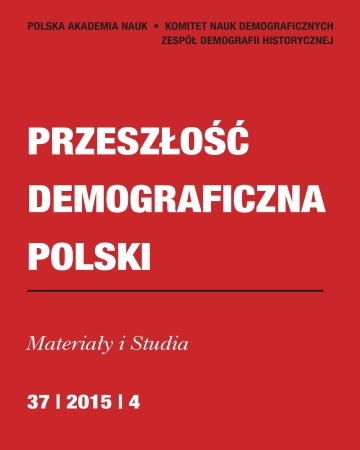








| Autorzy: |
Łukasz
Kozłowski
Archiwum Państwowe w Szczecinie |
| Słowa kluczowe: | marriages register Office documents newlyweds age Western Pomerania Szczecin (German: Stettin) Gumieńce (German: Scheune) |
| Data publikacji całości: | 2015 |
| Liczba stron: | 20 (105-124) |
| 1. | Anna Czop, Ruch naturalny ludności w parafii juncewskiej w latach 1801–1870 (na podstawie ksiąg metrykalnych), "Przeszłość Demograficzna Polski" 29, 2010. |
| 2. | Dariusz Szudra, Tendencje w przemianach demograficznych w pruskiej prowincji Pomorze na tle trendów ogólnoniemieckich w latach 1871–1914, "Przegląd Zachodniopomorski” 2000, 4. |
| 3. | Edmund Piasecki, Wiek nowożeńców urodzonych w latach 1751–1920 w parafii Bejsce, pow. Kazimierza Wielka, woj. kieleckie, "Przeszłość Demograficzna Polski” 8, 1975. |
| 4. | Emilia Brodnicka, Ludność parafii Wieleń nad Notecią w drugiej połowie XVIII wieku (rekonstrukcja rodzin), "Przeszłość Demograficzna Polski" 3, 1970. |
| 5. | Hanna Górecka, Alicja Janeczko, Ruch naturalny ludności parafii Sławięcice w latach 1804–1870, "Studia Śląskie. Seria Nowa" 40, 1982. |
| 6. | Hanna Kurowska, Gubin i jego mieszkańcy, Zielona Góra 2010. |
| 7. | Kazimierz Wajda, Stosunki ludnościowe na ziemiach pomorskich w latach 1850–1914, [w:] Historia Pomorza, t. IV: (1850–1918), cz. I: Ustrój, gospodarka, społeczeństwo, red. Stanisław Salmonowicz, Toruń 2000. |
| 8. | Lucyna Turek-Kwiatkowska, Kultura na Pomorzu w XIX wieku, Koszalin 2000. |
| 9. | Łukasz Kozłowski, Przekrój społeczno-zawodowy przedmieść Szczecina w latach 1875–1906 na podstawie akt małżeństw Urzędu Stanu Cywilnego w Gumieńcach, „Szczeciński Informator Archiwalny” 2013. |
| 10. | Radosław Gaziński, Agnieszka Gut, Paweł Gut, Dariusz Szudra, Maciej Szukała, Śluby w ewangelickiej parafii Jasienica pod Szczecinem w latach 1778-1880, "Przeszłość Demograficzna Polski" 28, 2007. |
| 11. | Sabina Rejman, Ludność podmiejska Rzeszowa w latach 1784–1880, Rzeszów 2006. |
| 12. | Stanisław Borowski, Rozwój demograficzny i problem maltuzjański na ziemiach polskich pod panowaniem niemieckim w latach 1807–1914, "Przeszłość Demograficzna Polski" 1, 1970. |
| 13. | Teresa Krotla, Ludność parafii bielawskiej w latach 1766–1830 (na podstawie ksiąg metrykalnych), "Śląski Kwartalnik Historyczny «Sobótka»” 46, 1992, z. 4. |
| 14. | Waldemar Pasieka, Śluby w parafii opolskiej w latach 1801–1850, "Przeszłość Demograficzna Polski" 21, 2000. |
| 15. | Zbigniew Klotzke, Ludność obwodu urzędu stanu cywilnego Luzino w latach 1874-1918, "Przeszłość Demograficzna Polski" 12, 1981. |